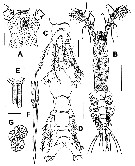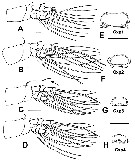|
|
 |
|
Monstrilloida ( Order ) |
|
|
|
Monstrillidae ( Family ) |
|
|
|
Monstrillopsis ( Genus ) |
|
|
| |
Monstrillopsis planifrons Delaforge, Suarez-Morales, Walkusz, Campbell & Mundy, 2017 (F) | |
| | | | | | | Ref.: | | | Delaforge & al., 2017 (p.1, Descr.F, figs.F, Rem.) |  Issued from : A. Delaforge, E. Suarez-Morales, W. Walkusz, K. Campbell & C.J. Mundy in ZooKeys, 2017, 709 [p.6, Fig. 2]. Female (from Dease Strait, Canadan Aectic): A, cephalic region (dorsal-; B,0 habitus (dorsal; arrow shows 3 paired dorso-medial papilla-like processes on 2nd pedigerous somite); C, urosome (ventral; showing P5, ovigerous spines not shown, only its insertion area); D, urosome (dorsal); E, insertion of ovigerous spines on ventral surface of genital double-somite; F, terminal section of ovigerous spines; G, eggs along ovigerous spines. Scale bars: 100 µm (A, C, D); 500 µm (B); 25 µm (E-G). Nota: - Cephalothorax (incorporating 1st pedigerous somite) approximately) representing 58 % of total body length (caudal rami excluded). - Oral papilla located at 20 % of way along ventral surface of cephalothorax. - Pair of relatively large ocelli present, pigment cups moderately developed, medially conjoinned, strongly pigmented; ventral cup larger than lateral cups. - Cephalic area with conspicuous protruding forehead process with flat, coarse anterior margin ornamented with transversely arranged cuticular ridges at its base. Pair of sensilla inserted at each side of the protruding frontal process. Cephalic ventral ornamentation complex. - Pedigerous somiyes 2-4 representing 24.7 % of total body length (caudal rami excluded). - 2nd pediger ornamented dorsally with 3 pairs of minute papilla-like processes on medial position (arrowed in fig.2B). - 3rd pediger with pair of small sensilla on anterior half (fig. 2B). - Urosome slender, 5th pedigerous somite, genital double-somite, preanal and anal somites, re^resenting 16 % of total body length (caudal rami excluded); relative lengths 31 : 38.2 : 14.1 : 16.7 = 100, respectively. - genital double-somite longest of urosome, with pair of rounded expansions on posterolateral margins; surface smooth; somite with rounded ventral protuberance on anterior margin and with shallow suture on lateral surface (fig.3 F). - Ovigerous spines arising ventrally from proximal half of genital double-somite; spines paired, relatively short, about 0.24 % of total body length, posteriorly reaching distal margin of caudal setae. Spines basally separate, slender, straight at base and along shaft, both distally tapering into acute points; left spine slightly shorter - Caudal ramus subrectangular, 1.9 times longer than wide, armed with 4 subequally long lightly setulated caudal setae.
|
 Issued from : A. Delaforge, E. Suarez-Morales, W. Walkusz, K. Campbell & C.J. Mundy in ZooKeys, 2017, 709 [p.7, Fig. 3]. Female: A, right A 1 ( dorsal view; showing armature following nomenclature by Grygier & Ohthsuka, 1995); B, cephalic area (lateral; showing forehead and preoral ornamentation); C, same (ventral; showing cuticular processes and ornamentation, arrow shows supernumerary spiniform element on 1st segment of left A1); D, detail of 1st and 2nd antennulary segments of left A1 showing supernumerary spiniform element on 1st segment (*); E, P5 (ventral view) showing small lobe-like processes on inner margin of exopodal (outer) lobes (arrowed); F, urosome, showing P5 and ovigerous spines (lateral). Scale bars: 200 µm (A); 100 µm (B-F); 50 µm (D-E). Nota: - A1 relatively long, slender, not straight, but divergent; representing about 31 % body length and 51 % of cephalothorax length; distinctly 4-segmented, segments 3-4 partially fused. Relative length of segments (from base to top) 12.1 : 29.2 : 17.1 : 41.6; last segment distally tapering. Antennulary armature patterns by Grygier & Ohtsuka (1995) including setae (Roman numerals) and spines 'Arabic numerals) and aesthetascs. - P5 medially conjoined indistinctly bilobed, inner (endopodal) lobe inconspicuous represented by small inner protuberance (arrows in fig. 3E). Outer lobe large, robust, with rounded margins; lobe armed with 3 subdistal setae; innermost seta shortest; all setae biserially and lightly setulated
|
 Issued from : A. Delaforge, E. Suarez-Morales, W. Walkusz, K. Campbell & C.J. Mundy in ZooKeys, 2017, 709 [p.9, Fig. 4]. Female: A, P1; B, P2; C, P3 with longer basipodal seta (arrow); D, P4; E-H, intercoxal sclerites of legs P1-P4, respectively. Nota: Incorporated 1st pedigerous somite and succeeding 3 free pedigerous somites each bearing of biramous legs . P1-P4 slightly increasing in size posteriorly, P1 being shortest. - Intercoxal sclerites of P1-P4 subrectangular, widest transversely, with rounded margins, with surface and posterior margins smooth; sclerites with decreasing size, that of P1 largest. - Basis of legs articulating with large, rectangular coxa along diagonal line. - Basis of P1-P4 with hair-like lateral seta; on P3, this seta about 6 times longer and slightly thicker than those on the other legs (arrowed in fig 4C) - Endopodites and exopodites of P1-P4 triarticulated. Ramus setae all biserially plumose except spiniform outer seta on exopodal segments 1 and 3, and inner seta of 1st exopodal segment, these latter being short and sparsely setulated. - Spine on exopodal segment 1 of P1-P4 long, almost as long as segment, reaching distal margin of succeeding segment. - Long apical exopodal setae of P1-P4 with inner margin lightly spinulose.
|
 ssued from : A. Delaforge, E. Suarez-Morales, W. Walkusz, K. Campbell & C.J. Mundy in ZooKeys, 2017, 709 [p.5]. Female: Armature formula of the swimming legs P1 to P4.
| | | | | NZ: | 1 | | |
|
Distribution map of Monstrillopsis planifrons by geographical zones
|
| | | | Loc: | | | Arctic (Dease Strait: Canada)Type locality: 69°1.5' N; 105°20.2' W. | | | | N: | 1 | | | | Lg.: | | | (1209)* F: 1,92; [F: 1,92]
* From anterior bend of cephalosome to posterior margin of anal somite. | | | | Rem.: | Delaforge & al. (2017, p.11) underline: the hydrologic characters of the lower Northwest Passage, distinctive due its relatively lower salinity (salinity of the water column varied between 28.4 - 28.8 and temperature was ca. - 1.5°C on the day of sampling the 2 June 2014, underneath ice-covered water column; depth of sampling station: 63 m).
For Delaforge & al. (2017, p.8) this species is assigned to the genus Monstrillopsis owing to its possession of the combination of characters noted by Sars (1921): 1- 2 free somites posterior to the genital double-somite; 2- eyes fully developed; 3- 4 segmented A1 in the female; 4- oral papilla occurring near the anteriormost part of the cephalothorax (< 20 % of way back along cephalothorax; 5- bilobed female P5, outer armed with 3 setae; 6- furcal rami with 4 setae.
The authors underline some specific characters: 1- relatively loner A1 (53 % of total body length); segmental pattern similar to that depicted by Dolgoposkaya (1948) for zernowi; 2 - fused antennulary segments 3-4; 3- P5 has an very weak inner lobe (represented by small protuberance).; 3- flat process on the forehead. | | | Last update : 19/06/2023 | |
|
|
 Any use of this site for a publication will be mentioned with the following reference : Any use of this site for a publication will be mentioned with the following reference :
Razouls C., Desreumaux N., Kouwenberg J. and de Bovée F., 2005-2025. - Biodiversity of Marine Planktonic Copepods (morphology, geographical distribution and biological data). Sorbonne University, CNRS. Available at http://copepodes.obs-banyuls.fr/en [Accessed December 30, 2025] © copyright 2005-2025 Sorbonne University, CNRS
|
|
 |
 |






